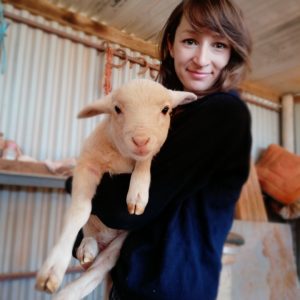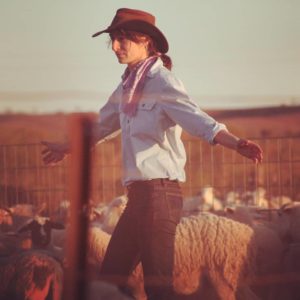A celebration of Australian farmers embracing renewable energy and diversifying land use to secure a future amid climate change.
Put simply, farmers are our front line of climate change. As a farmer myself and working closely with others in the farming sector, we are the first to experience the effects of drought and rising temperatures in Australia. Climate change is, without doubt, the biggest challenge our planet faces and it’s quickly becoming a mounting task for farmers in rural Australia to navigate.
However, even with this global threat knocking on our door every day, I am optimistic to learn farmers and the renewable energy industry are steadily increasing their collaboration in Australia. It’s no secret Australia has seen an increase in frequency and intensity of weather events; from drought to bushfires and wind storms, farmers across our continent have borne its full brunt. The implementation of innovative renewable energy technology will be crucial for farmers to sustainably diversify their income streams, continue to feed and clothe our population, and importantly, create a stable future for their families.
Large scale solutions require large scale landmass so I was excited to learn more about solar farms as part of my Ambassador work for Beyond the Burn; a creative photographic expedition led by Australian Geographic photographer, Ralph Alphonso and supported by the Smart Energy Council in collaboration with Nextracker Inc and the solar industry.
This celebration of large-scale solar growth in Australia also focuses on agrivoltaics, the practice of combining traditional farming, such as sheep grazing or crop growing, alongside large-scale renewable energy. The popularity of agrivoltaics is growing across the globe with one study from Oregon State University showing mutual benefit to sheep and solar panels. While the sheep kept the grass down and alleviated the use of herbicides, the solar panels provided shade to allow sheep to conserve their energy. I’d love to see more Australian studies in agrivoltaics to show how crops and livestock can co-exist with large-scale solar.
Beyond the Burn also provides a compelling way to tell the stories of rural Australians and showcases clever ways of land diversification to embrace renewable energy sources. I recently visited one of these farms in Karadoc, just outside Mildura in regional Victoria. Admittingly, this was my first time on a solar farm so David Alexander, Site Manager for BayWa r.e. gave me a guided tour through a sea of solar panels adorning outback Victoria. With 350,000 solar panels covering 664 acres of red earth, the 112 megawatt farm not only produces energy for the local community, interestingly, it also powers Carlton United Breweries through a 12-year Power Purchase Agreement. Check out their t.v. ad to see the farm in action
It’s great to see large Australian corporates lead sustainable practices and look to regional Australia for solutions.
 A standout feature of the Karadoc solar farm was the innovative Nextracker panels that follow the sun like a sunflower. Unlike fixed-tilt panels, solar tracking generates around 30 per cent more energy and ensures no sunlight hour is wasted. Considering farming is a big energy user, this type of technology is vital to ensure farmers can keep their businesses running on clean, renewable energy for longer.
A standout feature of the Karadoc solar farm was the innovative Nextracker panels that follow the sun like a sunflower. Unlike fixed-tilt panels, solar tracking generates around 30 per cent more energy and ensures no sunlight hour is wasted. Considering farming is a big energy user, this type of technology is vital to ensure farmers can keep their businesses running on clean, renewable energy for longer.
However, it’s the farmers behind each Beyond the Burn solar farm that really piqued my interest. In particular, the team talked about an 83-year-old gentleman from Nevertire, NSW, who went through the worst drought he’d seen in 2020. By taking the opportunity to lease a portion of his land to solar developers, he now feels confident he’ll leave a profitable and sustainable legacy to his family, no matter what the weather brings.
Farmers are also turning to solar as a means to shore up their energy supply and future-proof themselves from rising power prices, which represent yet another volatile threat to their businesses. With solar, farmers can not only become self-sufficient, but also diversify their business by exporting to the grid, and even leasing their land to solar developers who are willing to pay generously for the use of their property. Between farming, agriculture, mining, and manufacturing, regional industries are calling for more renewables, and it’s this demand that’s driving utility PV.
 These stories show that solar and agriculture can co-exist to result in big improvements to land productivity. And, although Australia is still navigating energy policies favoring fossil fuels and grid connection issues, there are opportunities for agrivoltaics and large-scale solar farms to create a secondary and a stable source of income for farmers. In fact, since the first solar farm was constructed nine years ago, large-scale solar now contributes 10.9 percent of Australia’s renewable energy generation. In May 2021, large-scale solar exceeded the average generation for gas for the first time (AER Q1-21 Market Report). This is a growing industry full of opportunities.
These stories show that solar and agriculture can co-exist to result in big improvements to land productivity. And, although Australia is still navigating energy policies favoring fossil fuels and grid connection issues, there are opportunities for agrivoltaics and large-scale solar farms to create a secondary and a stable source of income for farmers. In fact, since the first solar farm was constructed nine years ago, large-scale solar now contributes 10.9 percent of Australia’s renewable energy generation. In May 2021, large-scale solar exceeded the average generation for gas for the first time (AER Q1-21 Market Report). This is a growing industry full of opportunities.
The need for new research and investment in renewable energy technologies is crucial to support farmers with alternatives for land use and provide sustainable solutions for our changing climate. The voices of farmers and rural communities through campaigns like Beyond the Burn bring much needed attention to the energy challenges, solutions, and opportunities they so desperately want to grasp.
For so many farmers, being able to pass on their land to the next generation in the best condition possible is so important. This means evolving our practices and implementing new, clean technologies as they emerge. This can only make our rural communities more vibrant and resilient in the long run.
![]()
With so much amazing technology and innovation within our reach and continuing to expand, I’m hopeful our farmers, in collaboration with companies such as Nextracker and BayWa r.e., will continue to help better our communities, businesses and economy. Once we do, we’ll curb our reliance on fossil fuels and better our environment, and that’s definitely the future I want to see.
Follow the Beyond the Burn journey in retrospect through rural Victoria, Queensland, and New South Wales stopping at Bomen, Nevertire, Warwick, Jemalong, Bannerton, and Karadoc, meeting the workers and sharing stories along the way. Nextracker has been sharing regular updates via their Facebook, LinkedIn, Twitter, and Instagram pages.
Dr. Anika Molesworth is a thought leader of food and farming systems. With a Doctorate in Agroecology, Anika is passionate about creating a vibrant and sustainable global food system. She is committed to creating sustainable and climate-wise agricultural industries to meet the needs of the present without limiting the natural resources available or degrading their quality for future generations. Anika is the author of Our Sunburnt Country, which can be purchased here.